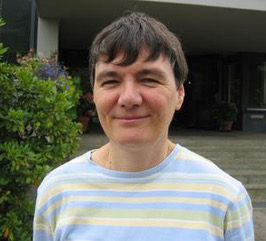Geneviève Raugel facts for kids
Quick facts for kids
Geneviève Raugel
|
|
|---|---|

Raugel in 2004
|
|
| Born | May 27, 1951 |
| Died | May 10, 2019 (aged 67) |
| Nationality | French |
| Education | École normale supérieure de Fontenay-aux-Roses University of Rennes 1(PhD and State doctorate) |
| Alma mater | Université Rennes I |
| Known for | Bernardi-Fortin-Raugel element Attractors Navier-Stokes equations |
| Scientific career | |
| Fields | Numerical Analysis and Dynamical systems |
| Institutions | Centre national de la recherche scientifique University of Rennes 1 École Polytechnique University of Paris-Sud |
| Thesis | Résolution numérique de problèmes elliptiques dans des domaines avec coins (1978) |
| Doctoral advisor | Michel Crouzeix |
| Influences | Jack K. Hale |
Geneviève Raugel (born May 27, 1951 – died May 10, 2019) was a brilliant French mathematician. She was known for her important work in two main areas: numerical analysis and dynamical systems. Her research helped us understand how to solve complex math problems using computers and how things change over time.
Contents
Geneviève Raugel's Life
Geneviève Raugel started her journey in mathematics at a special school called the École normale supérieure de Fontenay-aux-Roses in 1972. She became a certified mathematics teacher in 1976.
Her University Studies
In 1978, she earned her Ph.D. degree from the University of Rennes 1. Her special project was about "Numerical resolution of elliptic problems in domains with edges." This means she studied how to solve certain math problems that involve shapes with sharp corners using computer methods.
Working as a Researcher
The same year she got her Ph.D., Raugel joined the CNRS. This is France's National Center for Scientific Research. She worked there as a researcher from 1978 to 1994. Later, she became a research director, which is a very high position. From 1989, she worked at the Orsay Math Lab, which is part of the University of Paris-Sud.
Visiting Other Universities
Geneviève Raugel also taught and researched at many famous universities around the world. She was a visiting professor at places like the University of California, Berkeley in the USA and the University of Hamburg in Germany. In 2013, she gave special lectures in Atlanta, USA, honoring another famous mathematician, Jack K. Hale.
Leading a Journal
From 2005 onwards, she helped lead an important international science magazine. It was called the Journal of Dynamics and Differential Equations.
Her Math Research
Geneviève Raugel's early work focused on numerical analysis. This field is about using computers to find approximate solutions to math problems. She was especially interested in how to solve partial differential equations using a method called finite element discretization.
The Bernardi-Fortin-Raugel Element
With another mathematician named Christine Bernardi, she helped create a special method. It is used to solve a specific type of math problem called the Stokes problem. This method is now known as the Bernardi-Fortin-Raugel element.
Studying How Things Change
In the mid-1980s, Raugel started studying how things change over time. This is called the dynamics of evolution equations. She focused on global attractors. These are like "magnets" in math that pull solutions towards them over time. She also studied how small changes can affect a system, which is called perturbation theory.
One of her most important areas of research was the Navier-Stokes equations. These equations describe how fluids like water or air move. She was especially good at understanding these equations in "thin domains." This means she studied how fluids behave in very narrow spaces. She became a world expert in this complex topic.

